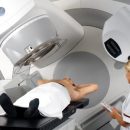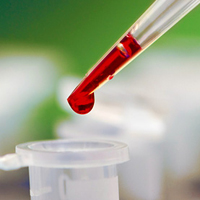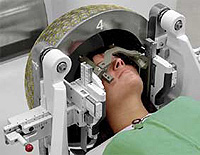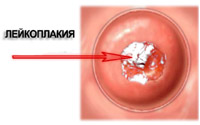Prostate cancer (prostate cancer) - malignant neoplasm arising from the epithelium of alveolar cell glands. Prostate cancer causes almost 10% of men's deaths from cancer and one of the main causes of death in older men.
Content
So, among men up to 45 years old mortality from prostate cancer is insignificant
(3 cases on 1 million. person.), However, after 75 years, this value increases
more than 400 times, reaching 130 cases per 100,000 people. Within the territory of
Russia prostate cancer is almost 2 times less often than the world as a whole.
However, the growth rate of the disease over the past 10 years has become so great,
that over the next decade the incidence can catch up with global
numbers.
Reasons for the development of prostate cancer
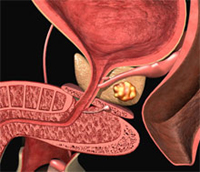 age hormonal changes in the body of men associated with
age hormonal changes in the body of men associated with
Changes in the hypothalamus system – pituitary – Adrenal - Eggs. W
Persons with a high androgenic background (for example, in people with high sexual
activity) prostate cancer occurs more often
- Genetic predisposition
- place of residence and racial affiliation (prostate cancer less
meets in Eastern Europe and Asia, more often in America and Scandinavia)
- Cadmium toxicosis (chronic intoxication by cadmium)
- Imbalance of nutrients (decrease in food vegetable products and vitamin
E Against the background of increasing the consumption of animal fats and proteins)
Prostate cancer
Quite often passes the stage of the prejudice, timely detection
which is extremely important in terms of forecast and treatment
Diseases.
TO Preiodant prostate gland relate:
- Atypical hyperplasia. This is a facultatic preference, which is able to move into cancer under certain conditions.
- Intraepithelial neopropasia. This is a bond predecessor of prostate adenocarcy.
Prostate cancer classification Founded
on the histological picture and the peculiarities of growth. Unlike adenoma
prostate, cancer most often develops in the peripheral zone and only in
10% of cases in the transient zone most characteristic of adenoma.
Highlight
adenocarcine (iron cancer) and flat-cell cancer of varying degrees
Differentiation, as well as a squirrel and solid cancer. Prostate cancer,
As a rule, it is characterized by a multi-grade growth and different levels
Differentiation of tumor tissue cells. Differentiation degree of cancer
It is customary to divide on 5 levels that determine its further classification
on Glisona. Depending on the resulting gleason number is determined
Forecast of the disease and tactics of further treatment. More
common in practice is TNM classification, giving
Clinical and histological characteristics of the tumor itself (t),
the presence and severity of the lesion of lymph nodes (N), the presence and
Characteristics of remote metastases (M).
Prostate cancer clinic
Symptoms,
characteristic only for prostate cancer, unfortunately does not exist. More
that, many symptoms are similar to those with the prostate adenoma
glands, which requires increased attention in their identification. Complaints
Patients are usually associated either with symptoms of tumor growth,
either with the advent of metastases. Due to a long asymptomatic
currents and late detection, more than half of the cases
Primary detection of prostate cancer already available metastases.
Usually, the tumor is found randomly with preventive or diagnostic examinations. Prostate cancer
Differs relatively slow growth. When metastasis
The spread of the tumor occurs both in circulatory and
lymphatic paths. With the growth of the tumor to the urethra
There are rapid urination, blood traces in the urine, violation
urination up to the acute delay. When germinating a tumor in
Neighboring organs (seed bubbles, bladder, rectum)
There are symptoms of lesion of these organs. So, from
urinary system may appear cystitis, pyelonephritis and even chronic renal failure.
Metastases are possible in bone tissue as a pelvic region and other
Skeleton departments. Nearest metastases are often accompanied by edema legs and
Midges. Remote metastases are most characteristic of the lungs, liver and
adrenal glands.
Prostate cancer diagnosis
The most effective methods of early diagnosis Prostaty cancer is an:
 Rectal finger prostate survey
Rectal finger prostate survey
- Rectal Ultrasonic Study Prostate (Transrectal Echography)
- Determination of the level of prostatic specific antigen (PSA).
All listed methods mutually complement each other and allow you to suspect or identify prostate cancer
In the early, preclinical stages of its development. So, determining the level
PSA gives from 15 to 40% of false positive and false-negative
Results, T.To. depends on factors as preceding massage
Prostates, instrumental surveys, inflammatory processes and even
ejaculation shortly before the study.
Other, more accurate
The method is determined by the prostatic density index
Specific antigen received by the ratio of the PSA level to the volume
Prostati. An even more valuable rate is the rate of increment
PSA level. With an increase in the level of antigen by 20% or more per year
need more careful study. Recently use
Also measurement of the ratio of the free and total PSA fraction, reduction
which speaks of a possible tumor process.
In general, diagnosis
The level of prostatic specific antigen – Extremely necessary
Examination for men older than 40 years. And if during the examination level
PSA above 2 ng / ml, this risk of prostate cancer is considered high, which means it is necessary an annual prophylactic examination.
Other methods of surveys include:
- Warofloometry
- Prostaty biopsy
- Ultrasonic examination of the abdominal cavity
- Radiological examinations, including computed tomography
- Radioisotope studies
- Magnetic resonance tomography and others.
Treatment of prostate cancer
How
and in many other fields of oncology the treatment method depends on
set factors. First of all pay attention to the stage
Diseases and degree of tumor differentiation.
With local forms
Cancer (without metastases) apply the following treatment methods:
- Removal of the prostate gland (radical prostatectomy). Remove
Prostate together with seed bubbles regional lymph nodes.
The most popular today laparoscopic technique operations as
The least traumatic.
- Remote radiation therapy. Irradiated
Prostate and regional lymph nodes at a dose of about 40 Gray
additional subsequent irradiation of the primary tumor to the total
Doses of 70 Gray.
- Brachytherapy or interstitial radial
therapy. The essence of treatment is the local irradiation of the gland
Microcapsules with radioactive preparations. «Grains» with drug
introduced under anesthesia with a special needle directly into the tumor
fabric, which makes it possible to significantly increase the dose of irradiation on the tumor and
reduce irradiation of healthy tissues. The results of treatment are better and
Complications less than when remotely irradiation.
- Monotherapy
Antanderrogen. This treatment is rarely used and carried out
patients who are not shown other types of treatment.
Treatment of prostate cancer
with nearest metastases usually comes down to maximum androgenic
blockade, including antandrogenic therapy with medication
or operational castration. Sometimes radiation therapy and
chemotherapy. Common (disseminated) prostate cancer
glands are usually as a rule, only symptomatic or palliative
Therapia. However, the use of antangrogenous and radiation therapy
able to significantly improve the quality and duration of the life of patients.

